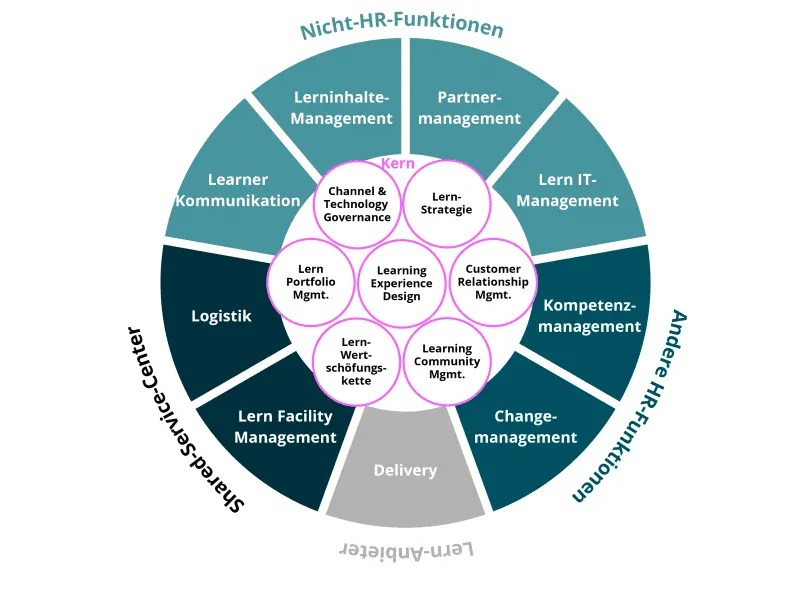
Corporate learning as a pioneer for the learning organisation
Nowadays, companies are under constant pressure to adapt. As a result, the transformation to a learning organisation has increasingly become the target vision of corporate development. Corporate learning is the way to shape and realise this vision. What is now possible becomes clear when you look at the progress made in corporate learning over the last few years. This also provides an opportunity to shed some light on the jungle of buzzwords.
What is meant by "corporate learning"?
The term "corporate learning" is generally used to describe the entirety of all programmes and methods that enable companies to invest in the skills of their employees. Traditionally, corporate learning encompasses training and further education programmes in face-to-face and online form.
Accordingly, corporate learning is often also used to describe the area of a company that is responsible for providing and managing the various learning opportunities and methods. Alternative terms are "Learning & Development" or "Personnel and Organisational Development".
The number of employees in Corporate Learning usually varies considerably from company to company - depending on the size of the company, the degree of centralisation and the depth of the value chain. Small centralised functions have 7 to 15 employees, while larger companies usually have between 25 and 50, but can also have several hundred. This usually also includes trainers.
In recent years, the corporate learning areas of companies have developed significantly. Four stages of institutional evolution can be distinguished:
Training administration
This primarily involves the procurement of requested content and formats as well as the implementation of training.
Goals
- Bundling of training requirements
- Cost-efficient training
Target group
- Not defined, ad hoc demand
Portfolio
- Training catalogue (classroom, virtual) with focus on individual needs
USP
- Knowledge of provider landscape and costs
- Reliable event management
Integrated training & development function
The focus is on providing systematic learning opportunities, including programmes, learning paths and functional or thematic portfolios.
Objectives
- Improving the effectiveness of training
- Quality assurance
Target group
- Functional groups
Portfolio
- Programmes
- Projects
USP
- Transparency
Business learning function
Characteristic features here are the close integration of learning programmes with business initiatives and targeted development support for critical target groups.
Objectives
- Capacity building for key business initiatives
- Leadership and talent development
Target group
- Teams, functions
portfolio
- Networks
USP
- Tailored to business context
- Integration into business processes
Learning organisation
Finally, the establishment of a company-wide learning culture and the systematic development of expertise/knowledge with corresponding best-practice transfer take centre stage.
Objectives
- Establishment of a learning culture
- Collecting and sharing knowledge
- Innovation as a competitive advantage
Target group
- Entire organisation
USP
- Organisational development & change expertise
- Knowledge management infrastructure
Training administration
This primarily involves the procurement of requested content and formats as well as the implementation of training.
Goals
- Bundling of training requirements
- Cost-efficient training
Target group
- Not defined, ad hoc demand
Portfolio
- Training catalogue (classroom, virtual) with focus on individual needs
USP
- Knowledge of provider landscape and costs
- Reliable event management
Integrated training and development function
The focus is on providing systematic learning opportunities, including programmes, learning paths and functional or thematic portfolios.
Objectives
- Improving the effectiveness of training
- Quality assurance
Target group
- Functional groups
Portfolio
- Programmes
- Projects
USP
- Transparency
What is a Learning Organisation?
The term "learning organisation" is generally associated with the idea that companies can significantly improve their ability to adapt and survive if they continue to develop through constant learning, especially in everyday business life. "Learning in everyday life" means above all: open exchange of knowledge, joint solution development, agile product development and a positive learning culture - across all business areas and hierarchical levels.
The term itself goes back to Peter Senge. In his book "The Fifth Dimension" (1990), Senge developed the guiding principle of the Learning Organisation, which is characterised by five core features: Personal Mastery, Mental Models, Shared Vision, Team Learning and Systems Thinking.
In practice
These rather abstract concepts have not been directly incorporated into corporate practice. Instead, more practical perspectives and terminology have prevailed. Nowadays, great value is placed on the adaptability and changeability of "learning organisations", their openness to empirical experience and the inclusion of individual learning. Insights into agile working methods and theories of adult learning have had a particularly strong influence: key topics here are self-reflection, uncovering unconscious biases, retrospectives with social learning in teams, iterative solution development and learning culture.
The model of a learning organisation developed by Alvaro Gonzales for the US Army is an illustrative practical application. Gonzales has applied Peter Senge's ideas to the specific requirements and conditions of the US armed forces. His concept is based on the traditional learning culture of the US Army, makes the target vision of the "Learning Organisation" comprehensible and enables officers and soldiers to adjust to the associated expectations from the outset.
Why are so many companies striving to become a Learning Organisation?
Basically, a learning organisation is able to change its attitudes and behaviour on the basis of experience - as a whole, for individual areas or departments, in teams and individually at employee level.
In detail, companies primarily associate development goals with a learning organisation, for example:
- Greater agility, faster adaptation to market/competitive changes, to changes in customer wishes and expectations
- Acceleration of technical progress
- More dynamic cooperation models with partners and suppliers
- More incentive and incentives for employees to ensure their own employability through lifelong learning
- Clarification of the general importance of individual learning, training and further qualification for employees
How can corporate learning support the transformation to a learning organisation?
The central task of corporate learning departments is to communicate the fundamental importance of learning for business success to employees and managers. With this in mind, it is important to develop a learning strategy tailored to the company that paves the way for a learning organisation.
The following individual tasks are particularly important:
- Ensure support from management and senior management. In particular, it is important to support managers in the implementation of corporate learning initiatives - and thus promote the desired learning culture.
- Identify the needs of learners across the organisation. This applies to both individual and large-scale upskilling and reskilling needs.
- Obtain and provide relevant information, expertise, concepts and tools for employees.
- Offer formats for all learning preferences - and create appropriate access channels with the relevant technologies.
- Integrate learning into work processes and thus provide effective learning experiences and build up expertise.
- Promote social learning, i.e. the exchange of knowledge and experience - among employees, but also in interactions with business partners and customers.
- Create the necessary framework conditions; this applies, for example, to access authorisations, offers, learning times or application contexts.
How should corporate learning be organised in a company?
The linchpin is a clearly defined customer interface, as proximity to business operations and learners is essential. This can be achieved by ensuring that corporate learning is consistently aligned with the customer service activities of the other divisions, for example. There are a whole range of tried and tested measures for improving cross-divisional cooperation: A special learning hotline could easily inform interested parties which learning programmes are currently available and which skills/further qualifications can be acquired with them. Key account management could be established for certain company divisions/functions. Its task - supported by contact persons in Corporate Learning - would be to identify critical learning and skill requirements before undesirable "talent gaps" occur.
Overall, the various areas of responsibility of Corporate Learning can be divided into core and peripheral. Core tasks are to be performed by the corporate learning department itself, while peripheral services can be provided in collaboration with other areas of the company or outsourced if necessary.
Core tasks include
- Administration and maintenance of the learning portfolio: Corporate Learning has two roles in particular here: Curator and coach. As a "curator", Corporate Learning ensures the operational availability of technology, learning programmes and methods. As a "coach", Corporate Learning monitors the development of learning behaviour and demand, ensures ongoing portfolio optimisation and coordinates the use of new learning opportunities and methods in day-to-day business.
- Provision of learning technology: Responsibility for learning technology, i.e. learning management systems, learning experience platforms, content management systems, authoring tools, etc. throughout the organisation should always be in one hand. This allows synergies to be realised and the learning experience of employees to be designed simply and uniformly.
- Design of learning formats: This is not just about developing effective learning formats, but also ensuring that they are optimally embedded in the company's workflows.
Peripheral services include:
- Learner communication and marketing as well as support for learning communities: all support services can - depending on their importance for the company - be offered by the corporate learning department itself or, if necessary, in collaboration with external service providers. These include storytelling around learning journeys, including graphic presentation (e.g. the learning journey as a sailing adventure) or the automation of communities with reminder emails and motivating rewards.
- Perception of service tasks: The spectrum here is broad. It ranges from purchasing external learning opportunities to organising physical training sessions, reporting and billing for services and data maintenance. If possible, these tasks should be bundled in a service centre. Such a centre can then also be operated in cooperation with other HR functions if necessary.

What questions are still unanswered when it comes to corporate learning?
Corporate learning has become an integral part of everyday life in modern companies. In one form or another, corporate learning has long since become a matter of course. However, there is a considerable need for clarification regarding the institutional anchoring of corporate learning within companies. Typical questions here are
What are recommendations for action on the path to a learning organisation?
For managers and those responsible for corporate learning, a number of measures have proven effective in moving closer to the ideal of the learning organisation:
- Explicitly describe a "way of learning" for the company in order to emphasise its importance and communicate the findings on adult learning - and in particular to focus on the topic of learner-centricity
- Clarify the investment nature of learning
- Formulate a learning strategy so as not to lose sight of the long-term overall picture and the necessary framework conditions in the daily routine of short-term learning needs
- Ensure that corporate learning employees focus on the roles that add particular value
- Win over multipliers in the business for the social learning that is so relevant - and strengthen their understanding of didactics
- Provide impetus and freedom for individual learning
- When designing customised learning opportunities, pay attention to the needs of the learners and a close integration with their everyday working life
We would be happy to discuss with you what these steps could look like in practice! Contact Axel Hüttmann, learning expert and partner in our Munich office, or book an appointment with him directly. Interested in other topics from our People Practice? Find out more.






